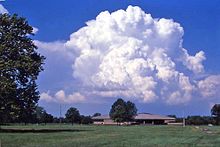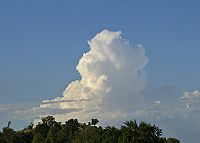- Towering cumulus cloud
-
Towering cumulus clouds can be based in the low or middle height ranges and achieve considerable vertical development (family D2) in areas of deep, moist convection. They are an intermediate stage between cumulus mediocris and cumulonimbus. There are several subtypes of this kind of cloud.
For specific information on this type of cloud, see:
Cumulus congestus
Cumulus congestus cloud 
A example of cumulus congestus clouds viewed from the distance.Abbreviation TCu Symbol 
Genus Cumulus (heaped) Species congestus Altitude up to 6,000 m
(up to 20,000 ft)Classification Family D (Vertically developed) Appearance sharp outlines and great vertical development Precipitation cloud? frequently,[1] but not always[2] often heavy. Cumulus congestus clouds (also towering cumulus) are characteristic of unstable areas of the atmosphere which are undergoing convection. They are often characterized by sharp outlines and great vertical development.[3] Because cumulus congestus is produced by strong updrafts, it is typically taller than it is wide, and cloud tops can reach 6 kilometres (20,000 ft),[4] or higher in the tropics.[1] Cumulus congestus clouds are formed by the development of cumulus mediocris generally, though they can also be formed from altocumulus castellanus or stratocumulus castellanus as well.[3] The congestus species of cloud can only be found in the genus cumulus.[3]
Cumulus congestus will mature into cumulonimbus calvus under conditions of sufficient instability. This transformation can be seen by the presence of smooth, fibrous, or striated aspects assumed by the cloud's upper part. This cloud type produces precipitation, often in abundance.
Cumulus castellanus
Cumulus castellanus 
Cumulus castellanus low on the horizonAppearance Flat on the bottom, though has multiple "towers" on top Precipitation cloud? Usually, but not always Cumulus castellanus (from Latin castellanus, castle) is a type of cumulus cloud that is distinctive because it displays multiple towers arising from its top, indicating significant vertical air movement. They are so named because they somewhat resemble the crenellation on medieval castles.[citation needed] Cumulus castellanus clouds are associated with the formation of towering cumulus or cumulonimbus clouds, and correspondingly can be an indicator of forthcoming showers and thunderstorms. The World Meteorological Organization does not recognize Cumulus castellanus as a distinct species, but instead classifies all towering cumulus clouds as Cumulus congestus.[5]
Turkey tower
Turkey tower is slang for a narrow, individual towering cloud from a small Cumulus cloud which develops and suddenly falls apart.[6] Sudden development of turkey towers could signify the breaking or weakening of a capping inversion.[7]
See also

This article includes a list of related items that share the same name (or similar names).
If an internal link incorrectly led you here, you may wish to change the link to point directly to the intended article.Bibliography
References
- ^ a b Richard H. Johnson, Thomas M. Rickenbach, Steven A. Rutledge, Paul E. Ciesielski, and Wayne H. Schubert. "Trimodal Characteristics of Tropical Convection". Journal of Climate (American Meteorological Society).
- ^ See "Weather Photo Gallery". University of Utah Department of Meteorology. http://www.met.utah.edu/galleries/home_page_images/cu_cong02.JPG/photo_view.
- ^ a b c "Glossary of Meteorology". American Meteorological Society. http://amsglossary.allenpress.com/glossary/search?id=cumulus-congestus1.
- ^ See "Life Cycle of a Thunderstorm". JetStream - Online School for Weather. National Weather Service. http://www.srh.noaa.gov/jetstream/tstorms/life.htm.
- ^ International Cloud Atlas
- ^ "Weather Glossary - T". The Weather Company. Weatherzone. http://www.weatherzone.com.au/help/glossary.jsp?l=t#turkey%20tower. Retrieved 2009-02-21.
- ^ "National Weather Service Glossary". National Oceanic and Atmospheric Administration. Central Region Headquarters. http://www.crh.noaa.gov/glossary.php?letter=t. Retrieved 2009-02-21.
Cloud genuses Extreme-level High-level Medium-level Low-level Fog · Stratus (St) · Cumulus (Cu) · Stratocumulus (Sc) · Arcus (Roll) · Fractus · Funnel · Nimbostratus (Ns) · Shelf · Wall · Actinoform cloud · Undulatus asperatusVertical Cumulonimbus (Cb) · Cumulonimbus mammatus · Pyrocumulus · Pyrocumulonimbus · Overshooting top · AccessoryCategories:- Set indices
- Cumulus
- Atmospheric science stubs
Wikimedia Foundation. 2010.





